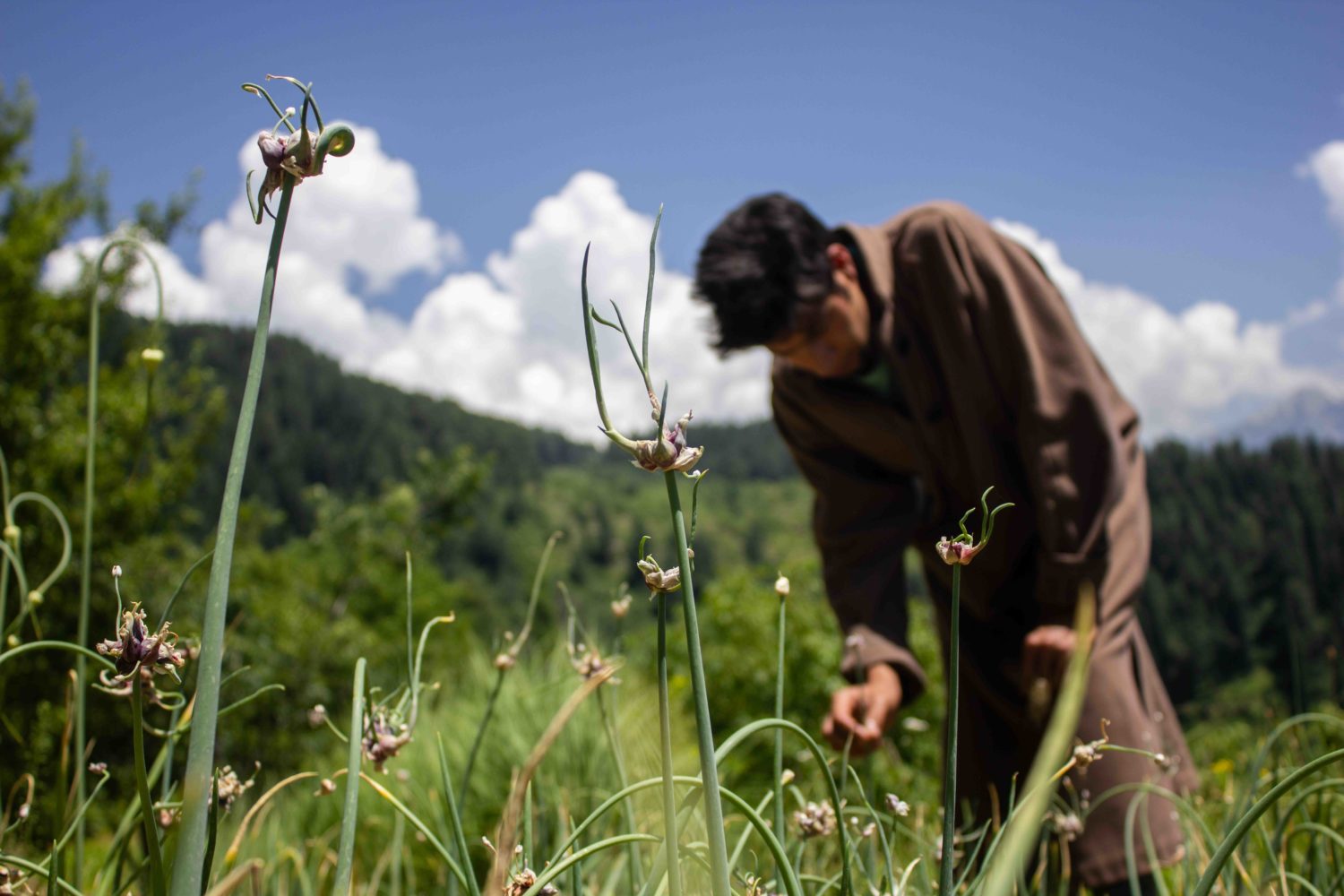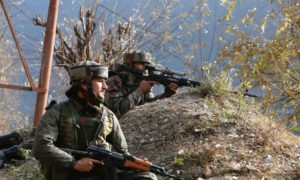“She has sowed the diamond in our lands which we are extracting.”
As one errands through the winding curves streaked amidst a canopy of trees, the glittering Wular Lake, and the alpine Wutlab valley in the depth of these mountains which escorts caravans to the Bhutoo hamlet, reminds one of the famous couplet by Ghulam Ali Bulbul, “Tragbal ki rifatoon sai dekh lo Wular ki jheel / Bandipora Misr hai goya Kinare Aab-e-Neel” (Witness the beauty of Wular Lake through the reflections of the surrounding mountains / Bandipora appears like an Egyptian marvel on the shores of the azure waters).
Nestled amidst baffled slopes and erratic nooks located 12 kilometres away from district headquarters Bandipora, the stiff crooked ranches of Bhutoo village holds a centuries-old legacy of filling Wazwan with the flavour and fragrance of the Kashmiri shallots locally called Praan.
In the sombre embrace of nature, with locked doors and empty nooks, where people throng to the farms, children brimming with enthusiasm, women displaying great zeal, and elders working with zest under the scorching sun in the stiff mountains, I accompanied Irshad Ahmad, a local farmer, to document the firsthand experiences of farmers cultivating crops worth lakhs. Amidst the hustle and bustle of the farms, from dawn to dusk, I closely followed several families as they worked together to harvest hope in the Bhutoo village.

[FPK Photo/Mohsin Mushtaq.]
Eyes buoyed by the sighting and nose by the smell of adequate crops, with the wrinkled warm face glinting with the drops of sweat under the exposed sun. Shamsuddin Reshi, a septuagenarian, acknowledges, “Ded Mouj” by saying, “The Sainte has been Allah’s blessing on us,” as he briskly cuts the grass covering with the sickle in his muddy hands of the hidden Praan under the mud. “She has sowed the diamond in our lands which we are extracting.”
Bibi Arifa, also known as “Ded Mouj,” was a renowned female Sufi saint from the 8th century. She is believed to have been born in the Handwara area of Kashmir. “In her quest for truth and Islam,” Bashir Reshi, a custodian of the shrine, states, “she willingly followed Baba Shakarud-din. Carrying gallons of water on her shoulders from Wullar Lake to the Shairkot mountain, where her mentor used to worship Allah in a cave.”
Impressed by her unwavering dedication as a devoted disciple, Baba Shakarud-din (RA) bestowed upon her the honour of having a shrine and place of worship, a privilege only granted to Baba Farid-din (RA) before, Reshi continues. “For Bibi Arifa, her mentor specifically chose the Buthoo area as her place of worship and shrine.”

[FPK Photo/Mohsin Mushtaq.]
The clang of the weeding hoe plunged by Shabir Reshi and co-op while sharecropping the digging operation, reverberates around the ranch, making the womenfolk more enthusiastic to gallop behind the queue and pull the Praan out of the mud.

[FPK Photo/Mohsin Mushtaq.]
Adroit hands taking a dekko at the newly unearthed crop.

[FPK Photo/Mohsin Mushtaq.]
Hafeeza (R), Shareefa (M), and Jabeena (L) sit parallel to each other filling the wicker basket while scouring the crop singly with knackered hands in the farmland huddled all along the majestic mountains.
Buoyed by the abundant crop, Hafeeza enthusiastically exclaims, “This year’s harvest surpasses the previous yield!” Her weary eyes focused intently on the weathered hands meticulously separating the muddy roots from shallot. “We have never used pesticides or fertilizers,” she sets the records straight about the nature of framing. “It’s the organic farming we practice.”
Picturesque Bhutoo hamlet carries the epitaph of producing 1500 quintals of Praan annually, making the village as the largest producer of shallot in the valley. The remarkable achievement has earned the village the distinction of being the first in the Kashmir division to receive organic certification.

[FPK Photo/Mohsin Mushtaq.]
Resting under penumbra, exhaling puffs with eyes gazing at menage, in simpering wrinkled face Mudasir Ahmad looks nostalgic while saying, “I vividly remember my ancestors gathering in the ground and preparing bandar before harvesting the crop.” And now youngsters harvest the crop which is their main source of income individually.

[FPK Photo/Mohsin Mushtaq.]
Shareefa carefully arranging the freshly harvested crops on a tarpaulin under the midday sun to ensure proper drying.
“Earlier it used to cost only Rs 15 a kilogram, rarely a quintal used to cost Rs 1500,” says Shareefa. “Now it is at a premium, but the brokers who buy it from us and sold it in the market pay us monetary equal to salt in wheat flour.”

[FPK Photo/Mohsin Mushtaq.]
“It’s like a village fair for us,” said Hafeeza as she scooped rice from the tub and spread it onto a slovenian platter. “We all sit together as a family and enjoy a meal after a long day of work.”

[FPK Photo/Mohsin Mushtaq.]
Cherished moment, a day’s labour culminates in family togetherness and nourishment

[FPK Photo/Mohsin Mushtaq.]
Shabir oversees the digging process during the late afternoon hours as the exhausted rapport prepares to wrap up for the day. They eagerly anticipate a refreshing break, looking forward to savouring a cup of Nun Chai prepared on a makeshift stone stove specifically set up for these strenuous harvesting days.

[FPK Photo/Mohsin Mushtaq.]
“Shameless and dishonest is a person who would exploit a shopkeeper during winter, only to sell the harvest to someone else in summer,” narrates Tahira. As she delicately picks up a cup of tea with her muddy hands, she passes it to Ahtisham, who taunts her family for giving the Praan to the shopkeeper instead of what they had bought from them during the harsh winter.
In the Buthoo hamlet, the residents heavily rely on shallot as their primary means of livelihood. However, during the cold spell, a significant portion of the population in Buthoo finds themselves isolated from the rest of Kashmir due to inadequate connectivity.
Consequently, the local inhabitants resort to purchasing goods on credit from shopkeepers. Then, in the summer, they settle their debts by giving the shopkeepers shallots as a form of payment.

[FPK Photo/Mohsin Mushtaq.]
As the elders keep strolling amidst patchy turf while dispensing the ripened crop, the youngling keeps vigilant on the folk to learn the centuries-old permaculture.
“I want to take the Praan into the International market,” anticipates teenager Jameel Reshi, a commerce student with a mound of hope who sinuously circumambulates on the bunds of his ancestor farmland while examining the crop ready to carry in a gunny sack.

[FPK Photo/Mohsin Mushtaq.]
“Monkeys and Porcupines are the only enemies of our crop,” Irshad Reshi while scrutinising the monkey attack on the crop mumbles. “We rely solely on organic farming methods, eliminating the need for any pesticides or insecticides. Monkeys do not permanently reside in these forests. They migrate from the Ayuthmulla forests when the crops are harvested. However, porcupines are present throughout the year, regardless of whether it’s the sowing season or the harvesting season, posing a constant threat to the crops.”
Harvested in late summer and sown back in August, the Praan in Buthoo Village requires careful attention during these days.
“The rains are both beneficial and perilous for the crop,” Rizwan says while checking the sapling cuttings. “Rains during sowing time are productive, but if the rains come during harvesting, they will destroy the entire crop in the area. We were playing hide and seek with the weather this season. Whenever we saw clouds approaching the sun, we would gather all the crops and store them in houses. People harvested earlier than usual this year due to the unpredictable weather.”

[FPK Photo/Mohsin Mushtaq.]
Amidst the mud-stained ceiling of his humble abode, Irshad Ahmad diligently completes the arduous task of harvesting, carefully spreading the crop.
Lost in contemplation, he marvels at the remarkable journey it has taken—from the delicate process of drying and meticulous cleaning to safeguarding it against the relentless intrusions of rats and monkeys.
As he gazes upon the final landscape, a sense of awe washes over him, for it is a testament to the unwavering resilience and genuine dedication that culminate in its vibrant presence within the bustling markets.












